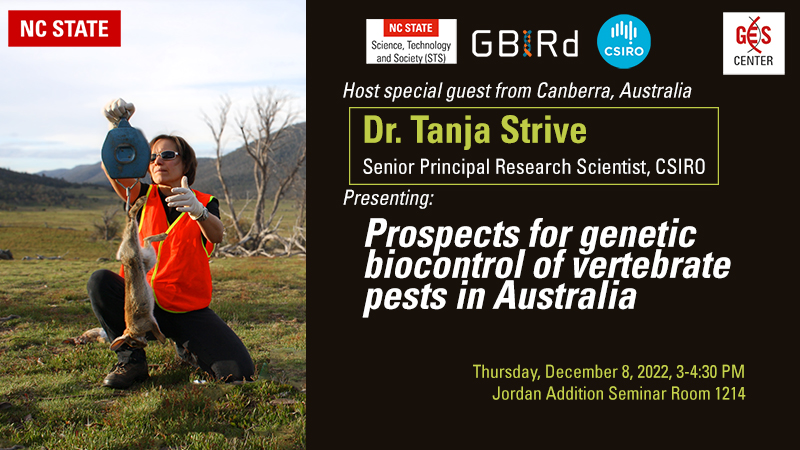
- This event has passed.
Special guest Tanja Strive, CSIRO – Prospects for genetic biocontrol of vertebrate pests in Australia
December 8, 2022 @ 3:00 pm - 4:30 pm

The NC State Science, Technology, and Society (STS) and GBIRd – Genetic Biocontrol of Invasive Rodents programs are pleased to host:
Dr. Tanja Strive, Senior Principal Research Scientist at Commonwealth Scientific and Industrial Research (CSIRO), Australia’s National Science Agency
“Prospects for genetic biocontrol of vertebrate pests in Australia”
Thursday, December 8, 2022, 3:00-4:30 PM in Jordan Addition 1214 seminar room
Abstract:
Deliberately or accidentally introduced invasive species have cost the Australian economy AUD$390 billion during the past 60 years, with vertebrate pests such as feral cats and rabbits amongst the costliest, and more effective landscape-scale management tools are needed. Novel revolutionary genetic technologies have recently been developed that can force modified genetic traits into an animal population, defying the constraints of normal Mendelian inheritance. Combined with a highly specific gene editing system, this technology has the potential for population control of pests, for example by creating all-male or female infertile offspring which would ultimately lead to the collapse of the target population. Delivered and spread through sexual reproduction the potential of this powerful new technology is unprecedented, making pest eradication theoretically feasible. Proof of concept in a mammalian model system (mice) has recently been achieved, raising the possibility of exploring these technologies for some of Australia’s most intractable and damaging vertebrate pests.
In line with the Guiding Principles for Sponsors and Supporters of Gene Drive Research (Science, 2017), in addition to technical developments, extensive consultations are currently underway in Australia with key stakeholders including scientists, government regulators, policy makers and public representatives. Moving forward it will be essential to ensure a transparent and informed debate, responsible conduct of science, provide a robust regulatory framework, and to identify key pathways and barriers to adoption of any putative genetic control tools.
Related links:
Speaker Bio:
Dr. Tanja Strive is a Senior Principal Research Scientist within CSIRO Health and Biosecurity, based in Canberra, Australia. A molecular virologist by training, she joined CSIRO in 2002 following the completion of the PhD at the Philipps University in Marburg, Germany. She has since worked on a series of projects investigating lethal and non-lethal, and both GM and non-GM, biocontrol options for a range of feral animal species, including European foxes, mice, cane toads and rabbits. During the past ten years Tanja has led a project portfolio of both applied science and fundamental research projects aimed at developing a pipeline of biocontrol tools for European rabbits, exploring both classical viral biocontrol approaches and more recently prospects for genetic biocontrol technology.
For more information, please contact Dr. Jason Delborne, Director of Science, Technology, and Society (STS) at jadelbor@ncsu.edu.